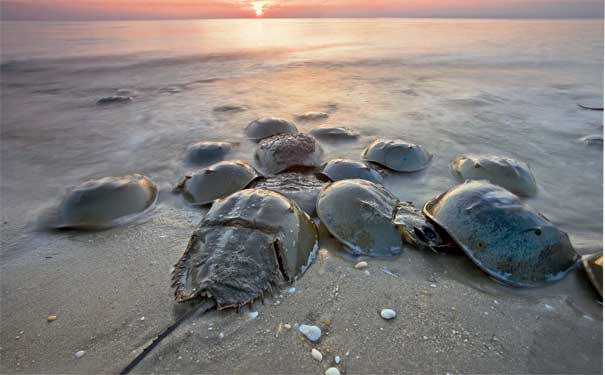Built the old-fashioned way
Despite their name, horseshoe crabs are not actually crabs — they make up their own class of animal, known as Merostomata (meaning “legs attached to the mouth”), a kind of arthropod. The creatures evolved in the Palaeozoic Era 540 to 248 million years ago with other arthropods that are now extinct, and their nearest living relatives are spiders and scorpions, all of them terrestrial and much smaller.
Just like spiders and scorpions, horseshoe crabs have six pairs of limbs. Five pairs are used for locomotion, and the foremost pair, called chelicerae, grip food. Horseshoe crabs are predators and carrion eaters. Their hindmost legs dig into the seafloor to find dead animals, worms, molluscs and other bottom-dwellers. The legs are equipped with leaf-like appendages that can sweep bottom sediment away to expose hidden carrion. The ends of each pair of legs are equipped with pincers to bring food toward the mouth. The legs also tear the food, so that the animal’s toothless, jawless mouth can swallow the meal.
The abdomen has six pairs of appendages, five of which are flat plates that function as gills (and as paddles to propel the horseshoe crab through the water). Each gill consists of about 150 lamellae that resemble the pages of a book. Like other gills, these extract oxygen from seawater. As long as the gills remain moist, the horseshoe crabs can use them on land as well — during egg-laying, for example — but only for short periods.
Because of their large carapaces, horseshoe crabs have a hard time righting themselves if they are turned over on their backs on the beach. A breaking wave on the shore can mean disaster for a horseshoe crab. It can use its tails to partially lift itself in an attempt to roll over and end up on its legs. But every year, about 10 per cent of adult horseshoe crabs become stranded on the beach and die of overexposure or are eaten alive by seabirds while on their backs in the sand. A horseshoe crab standing on its legs is well protected, given its tough carapace, against predators from above, but on its back it is easy prey.







